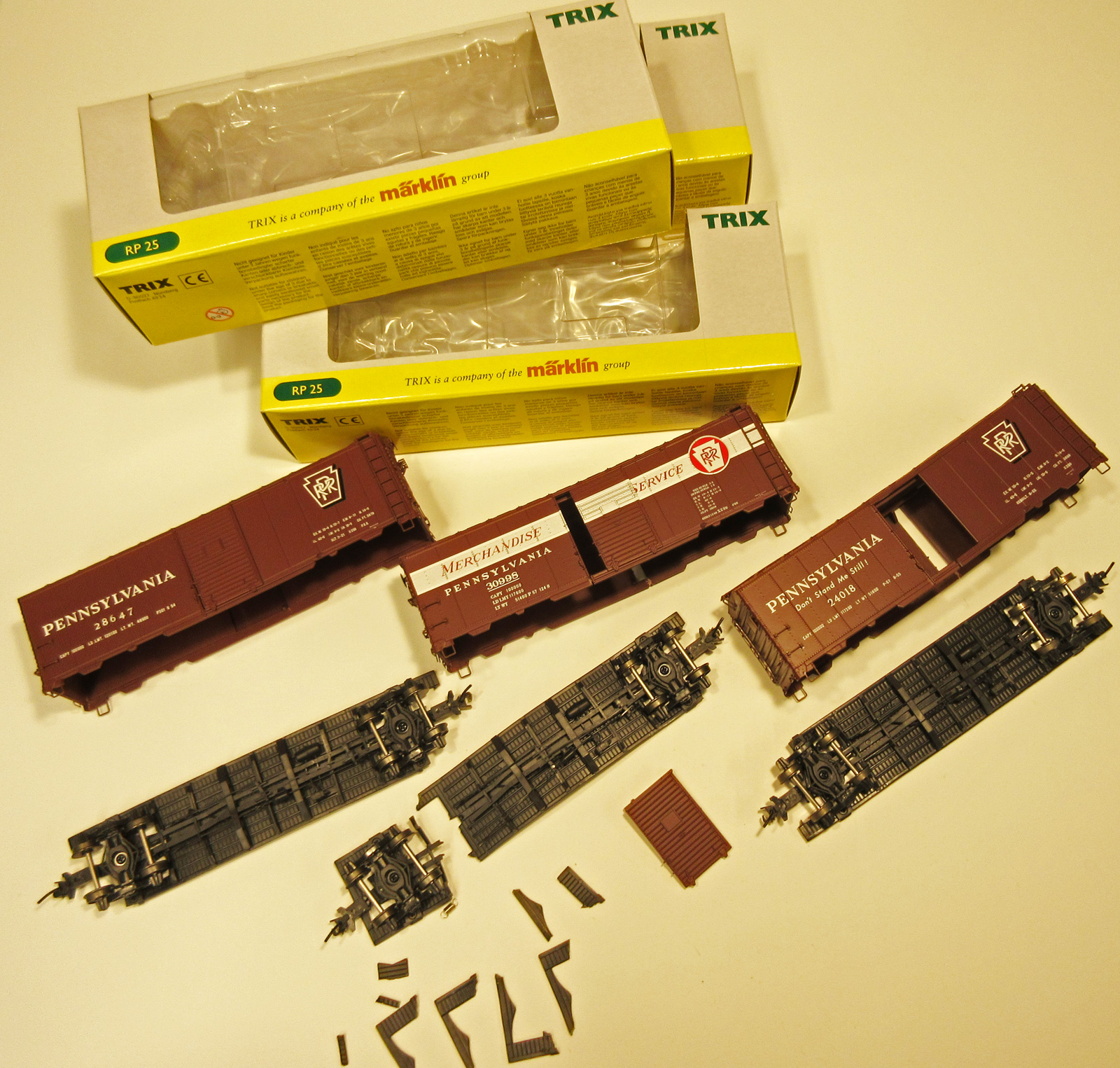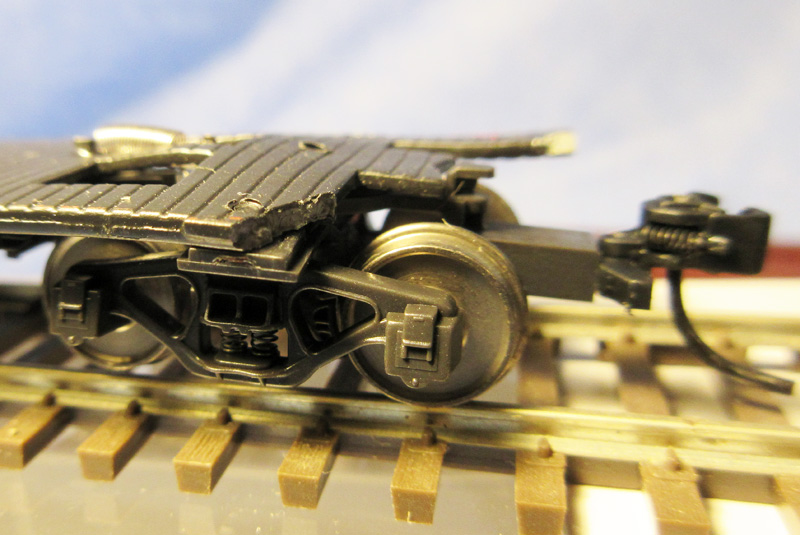All, I have seen a recent discussion on another forum that it appears several modelers have noted that their Proto 2000 GP-38 locomotives (HO scale) are suffering warping and crumbling frames which sounds like zinc pest. You may want to check your locomotives to see if your’s is afffected. Zinc pest is caused by impurities in the metal used by the manufacturer. It has popped up during the 1950s and recently reappeared with several Marklin locomotives as well. There is no known way to correct the problem short of replacing the frame.
I actually had to look that up, now I know. I have an old covered hopper track cleaning car that suffers from this. The inside of the cleaner reservoir is rotting from the inside out.
Mike.
The lead and trailing truck frames, identical pieces, of my Mantua 2-6-6-2 are effected by this problem.
.
Wargamers call this “Lead Rot”, and it can cause a beautifully paintewd army to fall apart.
.
Model Railroaders are lucky that is rarely effects painted/finished pieces. I would rather replace a frame then repain a banner bearer.
.
-Kevin
.
I discovered some of the Märklin zinc rot in a set of Trix boxcars I recently purchased:
The underframes of all three cars had warped and deteriorated severely. They expanded to the point of snapping the door rails where the frame fits into the body.
https://en.wikipedia.org/wiki/Zinc_pest
The seller refunded my purchase price and actually, I had planned to replace the underframes to eliminate the swing bracket of the coupler anyway.
My only other encounter with zinc-rot was on the weight of a BLI F7 locomotive. Since it really doesn’t have any mechanical function it can stay in place for now.
Thank You, Ed
I am really surprised that an old-line German company would still be selling models made with contaminated alloy.
I’ve got a box of 20 of their Union Pacific 40’ boxcars. I am NOT looking forward to having a look at their frames/floors. But sooner is better–it’s been pointed out that it only gets worse, and that it can damage the plastic bodies.
Ed
I would at least remove the frame from the body, a tight friction fit with a dimple at each side of the truck bolster, so that the frame can continue to expand but not deform the body.
Here’s a quick photo-slideshow.
Replacement frames with coupler pockets would be a nice thing to find (Hello, Shapeways?) The underframe didn’t have to be zinc, they could have molded it in plastic and used a separate weight.
Good Luck, Ed
Wonder if the GP60’s are affected.
I just looked at my collection of P2K GP7/9’s from the late 1990/early 2000 era and there is no sign of the problem. I remember looking at old used stuff from the 50’s and there was a lot of zamak ‘rot’ from that era. I suspect this is typical of Chinese cost cutting.
I wonder of the Chinese J2000 stealth jets are going to fall out of the sky over the next few years?
Jim
.
I have four Life Like GP 7/9, and one SD-7. All are OK.
.
I do not think this is a problem across the entire Proto 2,000 line.
.
-Kevin
.
They just might[:D].
I agree. I would estimate that I have maybe sixty or more Proto 1- and 2000 locomotives, both from the original Life-Like line and later Walthers, in HO and have not had any problems related to zinc pest.
Regards, Ed
Have four GP38-2’s went down to check them out and yes the zinc pest hit them one is so bad that it is stuck in the box got them in 2004 at $109.95 each [:'(].
Zinc pest has also hit the O scale crowed with both MTH and Atlas O having issues with body shells on MTH and trucks/couplers on both developing the issue. And, yes, I attribute it directly to Chinese cost cutting to make a buck. And poor QC on the part of both MTH and Atlas O. Same for other companies. I thought at one time, Marklin/Trix had a replacement program for those warped freight car underframes. Might be worth an email to them in Germany to enquire about replacements(for those unable to build thier own replacements). Mike the Aspie
I just came across a Proto GP38 recently that the frame was broke in numerous places.
This unfortunate problem also exists in the world of diecast toy cars from the 60s and 70s. I’ve seen numerous Hot Wheels from the early 70s still sealed in the original blister pack and all broke to pieces.
Mark.
This is really an unacceptable situation.
Corporate sellers (they’re not manufacturers anymore - someone else is, and Atlas, BLI, etc. simply specify the product they want manufactured) should be specifying a casting material that will not exhibit this problem at some point. Failing to do so is irresponsible at the least, and they should be held accountable for replacement costs. It isn’t as if the rot is a recently discovered characteristic of the material, after all.
If the sellers are specifying materials that are not susceptible tho the problem, they should hold the manufacturer financially responsible, as the manufacturer did not build per the contracted specifications.
Instead, the end purchaser is far too often left holding the bag for the defective items they purchased.
Some call them importers.
I agree, should. I imagine everyone agrees but in many cases not much we can do.
Unfortunately many of these items were manufactured 15 or 20 years ago. Who knew they had an expiration date and would self destruct.
Three words:
Google Chinese Drywall
Pretty much any relatively competent manufacturer working with these materials knew - the problem first cropped up over 50 years ago. I think they just didn’t care. Get it out the door cheap and get the money. Spending an extra 5 cents on a material that doesn’t eat itself in the relatively short term would reduce profit by that same 5 cents. Can’t do that!
Hi all,
I just checked three Protos I have, a GP38-2, GP9, and SW8 I picked up all about the same time in 2004 and they all seem fine. My question is since this seems to mostly effect the P2k GP38-2s I’v read about here, if mine is still ok after all this time, is it going to stay that way? Or is this something that can still happen?
Thanks, Ralph
I’m not seeing problems with P2K Geep 7/9/20/30 engines. My Marklin/Trix hoppers and cabooses are marked “Made in China” and the center sill on the hoppers feel like they may be metal. Don’t see issues with the two that are close at hand.


